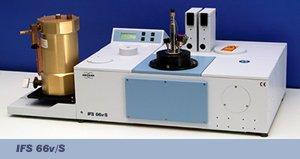|
Instrument Database:
Bruker Optics - IFS 66v/S Vacuum FT-IR
| |
|

|
| |
|
| |
|
| Year of introduction |
|
| Status |
available |
| Company |
Bruker Optics
|
| Categories |
Spectrometer ( Molec. ): FTIR
|
The Bruker Optics IFS 66 series FT-IR spectrometers are well known for their outstanding performance; setting the standard for high-level research grade FT-IR systems. Digital Signal Processing (DSP) electronics provide full automation and precise scanner control for demanding applications such as step scan experiments. Add this to highest sensitivity, full range expansion and multiple beam ports and you have the ultimate research FT-IR spectrometer.
- Full spectral range coverage from the very far infrared ( <5 cm-1 ) up to the vacuum UV ( >55,000 cm-1 )
- Spectral resolving power of better than 100,000:1 or <0.1 cm-1 spectral resolution
- Outstanding signal-to-noise: peak-to-peak noise of less than 10-5 AU achieved within 1 minute and 4 cm-1 spectral resolution
- Time resolved spectroscopy:
o More than 100 spectra/sec Rapid Scan at 12 cm-1 spectral resolution
o Step Scan temporal resolution of <10 nsec in the mid IR- Slow Scan with less than 0.006 cm/sec optical velocity
- Vacuum optics available: IFS 66v/S
IFS 66/S
The IFS 66/S is the ideal spectrometer for the demanding research laboratory. The precise air bearing and high quality optics provide the ultimate in sensitivity and stability. Stable construction enables the IFS 66/S to perform demanding experiments such as step-scan, ultra fast rapid-scan, high resolution or UV measurements. This high performance is further enhanced by the flexibility and expandability of the IFS 66/S. Up to three external beam ports and two focused input ports are available for adding any of the many external accessories available from Bruker Optics.
IFS 66v/S Vacuum FT-IR
IFS 66v/SIt's a fact that the atmosphere outside your spectrometer can affect the data you are collecting on the inside. Regardless of how well you purge your FTIR, water vapor and other interferents can show up as undesired peaks in your spectra. But there IS an alternative: By constructing a vacuum housing for the spectrometer it is possible to record spectra free from gas phase interferents such as H2O or CO2. Bruker has been building vacuum FT-IRs for more than 25 years and has installed hundreds of vacuum benches all around the globe.
Take all the advanced features of the IFS 66/S, add evacuated optics and you have the ultimate research FT-IR system: IFS 66v/S. A vacuum environment provides outstanding sensitivity and stability, especially for measurements in the FIR region. The IFS 66v/S has an optional third external detector port which can accommodate a liquid He cooled bolometer, thus permitting measurements down to 5 cm-1. An extended range FIR beamsplitter allows measurements from approximately 700 to 20 cm-1 without using multiple mylar films.
High Performance for all wavelength ranges
Traditionally FIR has always posed a problem for infrared analysis due to low throughput and the high absorbance of water vapour in the region. Working in a vacuum environment significantly improves the spectral quality in this region, especially for high resolution measurements. The adjacent spectra of borate glass demonstrate the spectral quality obtainable in this region with the IFS 66v/S.
Rapid and Step Scan
Fast rapid scan rates of greater than 100 spectra/sec at 12 cm-1 spectral resolution can be achieved by the friction free air bearing scanner of the IFS 66 series. Combining these very fast scan rates with superior precision, the examination of kinetic processes in the low msec range is possible.
For very fast repetitive kinetics experiments the spectrometer can be upgraded with the step scan option. Together with fastest analog-to-digital converters and photovoltaic liquid N2 cooled MCT detectors, a temporal resolution down to less than 10 nano seconds could be achieved. IFS 66v/S customers have published many papers demonstrating the exceptional performance of the instrument for time resolved spectroscopy in the IR spectral range.
The integrated DSP electronics allows phase and amplitude modulation experiments and even the combination without use of external lock-in amplifiers (LIA). In the case of photo-acoustic (PA) depth profiling measurement, the availability of high phase modulation amplitudes of up to 20 HeNe wavelengths is very beneficial with respect to signal-to-noise in the fingerprint spectral range. For example superior results can be achieved by combining step scan phase and amplitude modulation techniques with a polymer-stretching device.
|
| Specifications |
|
|
|
|